Executive Summary
This case study supports and illustrates the theoretic factsheet "Social marketing for safe water" with practical insights.
Tinkisso leveraging its success through social and commercial marketing activities in Guinea
Tinkisso-Antenna is an NGO with a social enterprise arm based in Conakry, Guinea. It uses entrepreneurship and a market based approach in order to market liquid chlorine in different regions of the country. WATA™ technology is used to produce the chlorine which is branded as “Chlore’C“ (image below) and sold in 250ml flasks.
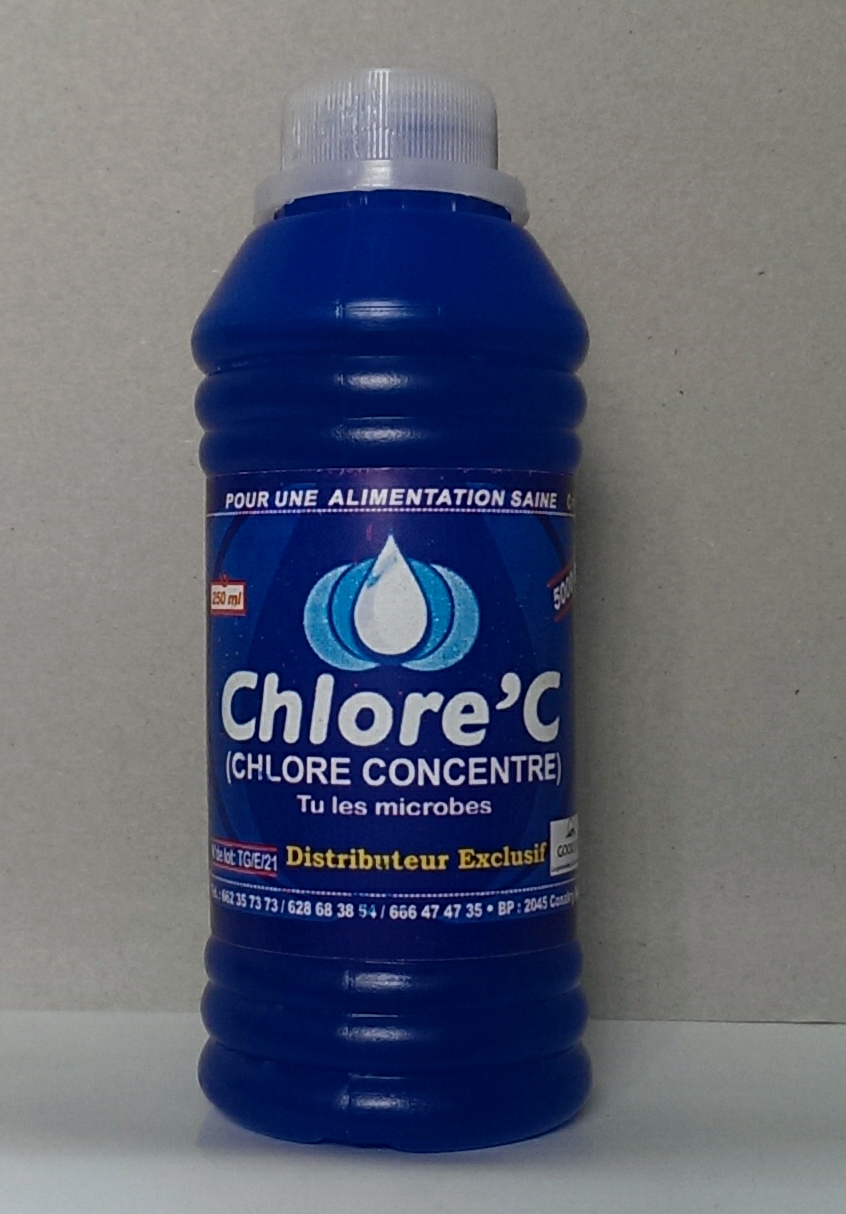
Source: Tinkisso,
2016
Tinkisso’s origins can be traced back to 2008, when in a first pilot project initiated by Antenna Foundation and UNICEF the production and sales of chlorine was successfully tested in the northern region of Guinea. The significant decrease in number of diarrhoea and cholera cases within the intervention zone cemented this multilevel partnership and built the basis to leverage the success. To date Tinkisso centralised its chlorine production in Conakry and distributes Chlore’C through different channels, reflecting a diversified distribution strategy with direct sales to urban communities, through a reseller network (kiosks, pharmacies, sales points) and institutional channels (Ministry of Health and UNICEF). Today, Tinkisso is operating in 5 provinces (Conakry, Boké, Kindia, Mamou and Labé) and has delivered over 700,000 chlorine flasks in 2016 reaching over 100,000 people.
One important factor of this success is the development of comprehensive social marketing activities, allowing Tinkisso to raise awareness about safe water even in remote and rural areas of Guinea.
To raise awareness Tinkisso-Antenna uses a step-by-step approach combining a social and commercial marketing strategy (see pictures below):
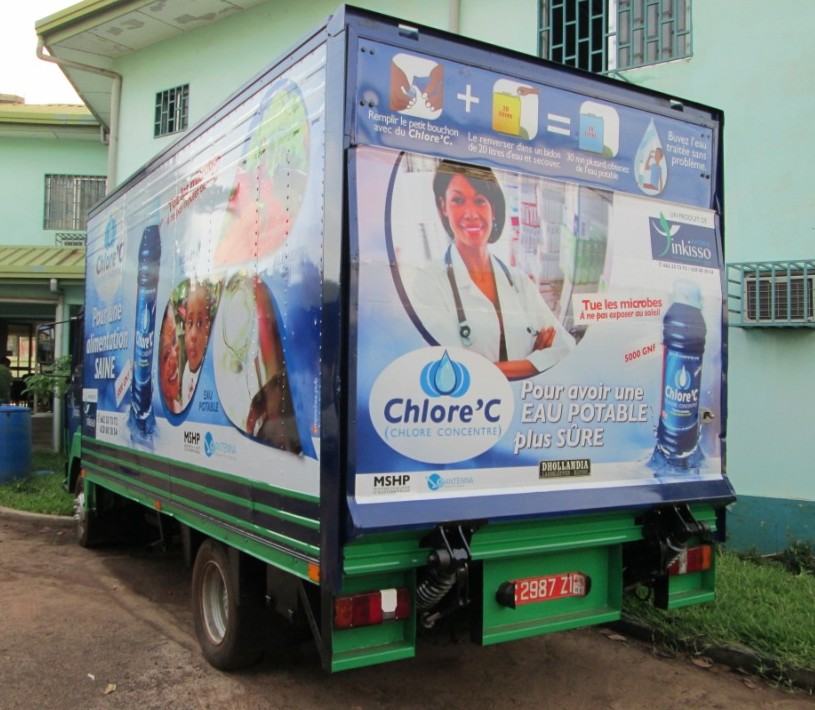
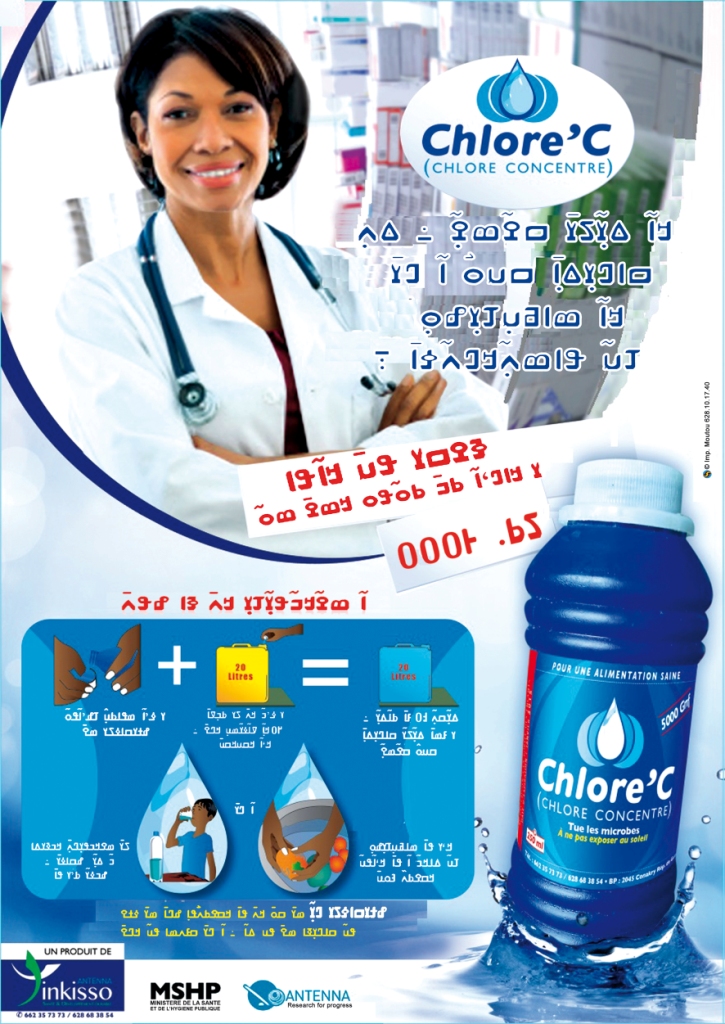
At the beginning of the initiative (2009) a partnership with regional health centres and local NGOs was initiated in order to combine awareness-raising campaigns and to foster local sales of chlorine at low costs through door-to-door activities. By time Tinkisso developed a social marketing team, where social marketing agents are hired and trained in-house. These agents execute awareness raising campaigns directly to the target audience and address also influencers and trusted people (e.g village leaders, imams and priests), who are able to deliver the message of safe water to their respective target audiences. Pursuing such strategy allows that people are reached in their accustomed environments and by trusted people. Talking to people in their accustomed environment facilitates the adoption of behaviour. Beside Tinkisso developed a broad network with community institutions such as mosques and churches, community centres and raises awareness in schools, public markets, sales points etc. through plays, door-to-door campaigns and with speakers on trucks. Beside these activities on the ground commercial activities lead to an increased product visibility.
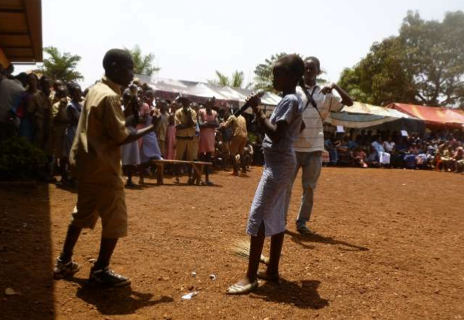
The support of Population Services International (PSI) and UNICEF has also been key to broadcast TV and radio advertisements and to leverage social marketing on a national level.
It is key to remember in the case of Tinkisso that Guinea was hit by the Ebola outbreak in 2015, where consequent funding was allocated toward WASH and fighting waterborne diseases. UNICEF allocated USD 1 million a year to raise awareness on the dangers of unsafe water. It is an example of a large social marketing campaign that can drive behaviour change, particularly in emergency situations. It is unfortunate though that as soon as the Ebola crisis stopped, funding was drastically cut, returning to day 1 with old habits kicking back as people perceive to be safe and don’t see a need to treat water without the prevalence of an epidemic.
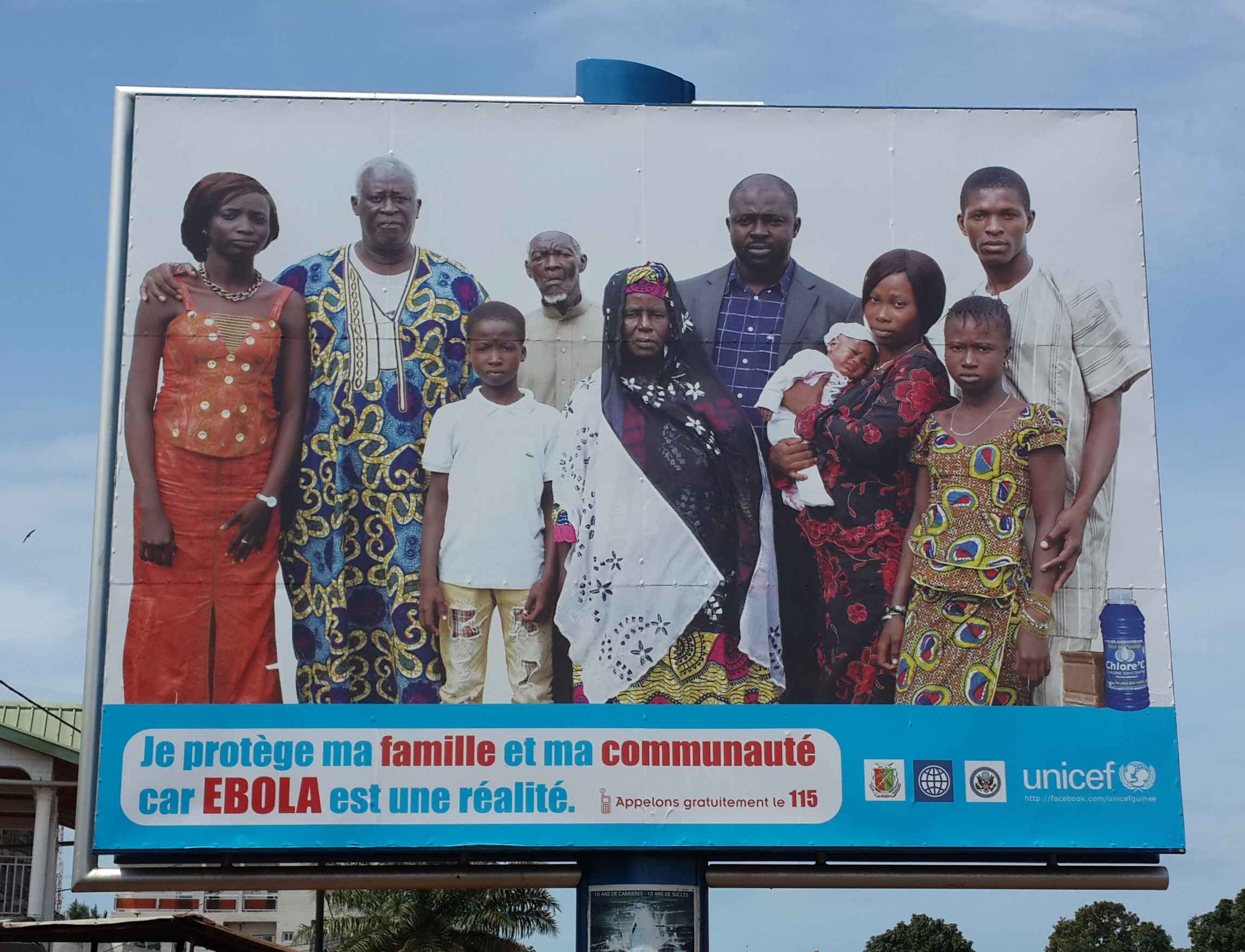
Lessons learnt and recommendations on social marketing for BoP customers
Combining commercial and social marketing
Combining commercial and social marketing activities is key in order to increase your products visibility and in parallel to change behaviour and increase the knowledge about the importance of drinking safe water. Though social marketing is brand-agnostic it increases the overall importance and knowledge of drinking safe water. While commercial marketing increases the visibility and recognition of the product as such and can also be combined with social marketing message (compare picture above).
Coordinate activities and join hands
While doing social marketing it is essential to work and collaborate with institutional actors active in social marketing (UNICEF and PSI) and to streamline and coordinate activities in reaching people most efficiently. Social marketing should not be perceived as competition but as mutual effort towards informing people about safe water and pertinent behaviour. Successful campaigns distribute the focused behaviour change in an attractive and convincing way in parallel to aspirational products and solutions that people are developing a crave for. Arguments that work are not only health arguments, but means of aspiration, time saving of water filters instead of boiling, or the health for kids and elderly etc.
Social marketing and trust
Identifying and working together with people that are trusted within a community can leverage the success of social marketing activities. If trusted people are adopting behaviour change it can help triggering change within the community as people are more likely to adopt and change behaviours if a trusted person is advocating for it rather than strangers. Also combining social marketing activities with locally established structures like self-help groups has been found being very promising. For example is Spring Health working together with women self-help groups that are going door to door to sell purified water. In certain villages their penetration rate reaches up to 90 percent of households. A clear advantage of using these established structures is that the women are known in their community, which facilitates contacts and trust. This fact facilitates sales as trust is already built and on the other hand it allows the women to gain additional income and empowerment.
Keep costs in mind
Social marketing is costly in terms of time and money. Such costs shall be fairly shared among public health institutions and at the level of market creation.
Recommendations for replicating social marketing activities
Urban vs. rural
Commercial activities shall be initiated in urban areas, where distribution is easier and less costly as existing distribution channels are (or should be already) in place. Accordingly a foothold with local wholesaler can be created to afterwards connect them with village-level resellers identified during your social marketing campaigns. Rural areas are a challenge: being an inclusive business to reach BoP in rural setting is a complex topic. In cities it is easier to reach more people with a campaign due to population density and usually better infrastructure. But never forget social marketing activities in rural areas where people lack access to information. Social marketing shall cover a whole country. Vice versa can the adoption of new behaviour in rural areas help building up a sort of pressure on urban areas, as urban people don’t want to stay behind their rural compatriots.
Build on existing structures
Try to engage regional health structures for your social marketing activities: People who visit health centers for treatment are most likely to be receptive for health prevention advices, especially if it comes from health care professionals. Furthermore, working together with existing networks is cost-effective to spread your social marketing messages and your product among the population.
Align with government’s strategy
For success a social marketing strategy should encompass and align with a government’s national public health policy and strategy to leverage all stakeholders and align activities in a comprehensive and efficient manner. Such activities are usually organized in respective national and regional WASH-clusters. In order to align your company’s social marketing efforts it is highly recommended to participate in such WASH-cluster meetings. Please contact your country’s local WHO office for more information (WHO national clusters).
More lessons learnt in social marketing for safe water of the Safe Water program phase II partners. The Safe Water Program Phase II is a 3-year project funded by the Swiss Agency for Development and Cooperation (SDC) and Aqua for All, with the aim to increase access to safe water at global scale and to contribute to the human right to water through integration of the business models in the national regulation. Supported and documented businesses are ECCA and MinErgy in Nepal, PakoSwiss in Pakistan, Spring Health and TARA in India, Tinkisso in Guinea, and Hydrologic in Cambodia.
- Social marketing activities are context-specific: there are situations where people already have a high degree of awareness. For instance, in Cambodia, over 70 % of people are boiling the water and little efforts are required to create awareness about safe water. Similar experiences can be made in areas with frequent cholera outbreaks. For example in Goma (Democratic Republic of Congo) where people and societies are aware that safe water is a key element to survive and people prefer water with a light chlorine taste because they know it is safe to drink.
- Community engagement is key: one must understand why certain habits exist and why it is hard to change them. Also, testing the developed marketing strategy in a few communities before rolling it out is important on a national level is important to hone insufficiencies.
- Social marketing should take place on systematic, continuous and regular basis in order to really implement changed behaviour in people’s daily lives.
- BOP customers are often very cautious and conservative with the little money they earn and have often bad experiences with companies who sold them low quality products. Your company’s offering has to prove quality, that there are clear benefits using the HWTS or safe water at an affordable price. Comparisons to health cost savings, higher income due to less sick days and healthier live as such should be considered.
- Social marketing activities should be undertaken in a comprehensive and holistic way, addressing the whole population. As examples serve the programs implemented by UNICEF (WASH in schools) or the WHO (WASH in health care facilities), which are pillars of the SDGs 6 and are showing the way for a harmonised WASH strategy at the government level.
Sustainable access to drinking water through the development of a social enterprise in Guinea
Marketing safe water to the base of the pyramid – lessons for scaling up a social enterprise in Guinea
This paper discusses market based approaches to safe water in the context of the Guinean NGO Tinkisso-Antenna. Not only can profit-oriented businesses achieve long-term financial sustainability but also do they have the potential to grow in size. Challenges of scaling up and replicating social enterprises in the safe water sector are discussed and lessons learned provided why doing business at the bottom of the pyramid is no easy task.
BÜHLMANN, A. (2014): Marketing safe water to the base of the pyramid – lessons for scaling up a social enterprise in Guinea. (= Master's Thesis ). University of St. Gallen URL [Accessed: 16.04.2018] PDFAccess to Safe Water for the Base of the Pyramid – Lessons Learned from 15 Case Studies
The book provides insights on how innovative approaches led by social entrepreneurs, NGOs, and corporations have proven that sustainable solutions could provide safe water at the Base of the Pyramid. To illustrate these findings 15 case studies are provided of innovative social enterprises active in Africa and Asia.
HYSTRA (2011): Access to Safe Water for the Base of the Pyramid – Lessons Learned from 15 Case Studies. Hybrid Strategies Consulting URL [Accessed: 16.04.2018] PDF
